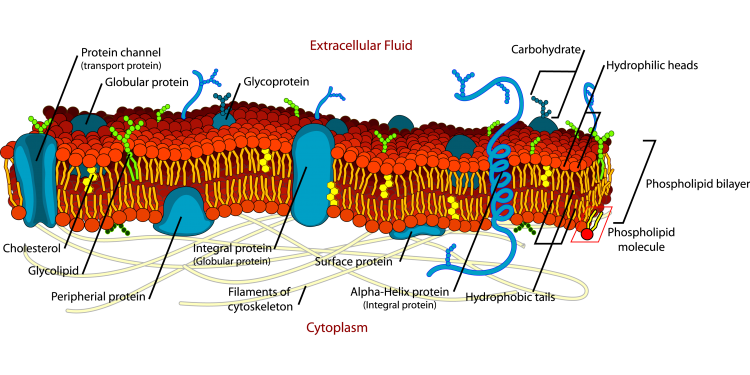
Researchers from McMaster University accessed the CNBC to make ground-breaking observations of order in cell membranes.
Source: Canadian Neutron Beam Centre (CNBC)
Contact: cnbc@cnl.ca
Image: Diagram of a cell membrane
To explain a wide range of cellular functions, many researchers propose the existence of so-called ‘rafts’ in the cell membrane, which can be described loosely as tiny islands of order floating in oceans of less-orderly lipids. It is believed that these rafts are induced by cholesterol, and cholesterol is known to play very important roles in determining the structure of the membrane. Observing and characterising these rafts is urgent fundamental knowledge that is needed to advance our understanding and direct future research, but doing so has eluded many researchers until now.
 Professor Maikel Rheinstädter of McMaster University and his students made the first direct experimental observations of rafts in a fluid lipid membrane consisting of a binary lipid-cholesterol mixture, and are the first to observe the lipid structure within the rafts. They used the neutron beams at the CNBC to reveal details of the order in the membrane, suggesting a picture of the membrane as a liquid with small structures, including highly dynamic rafts.
Professor Maikel Rheinstädter of McMaster University and his students made the first direct experimental observations of rafts in a fluid lipid membrane consisting of a binary lipid-cholesterol mixture, and are the first to observe the lipid structure within the rafts. They used the neutron beams at the CNBC to reveal details of the order in the membrane, suggesting a picture of the membrane as a liquid with small structures, including highly dynamic rafts.
Rheinstädter’s team used a special variation of neutron diffraction to conduct this experiment. The size of the cholesterol domains within a disordered membrane are so small that the domains cannot be observed in a typical X-ray or neutron diffraction experiment. In a typical powder diffraction experiment, the size of the grains in the powder may be just smaller than what the eye can see but are large enough to effectively scatter probes such as X-rays or neutrons. The lipid rafts are much smaller in volume. A key factor that defines what is too small is the coherence length of the beam. By reducing the coherence length of the neutron beam down to the scale of the nanometer-sized rafts, Prof. Rheinstädter was able overcome these issues and study smaller patches of membrane.
